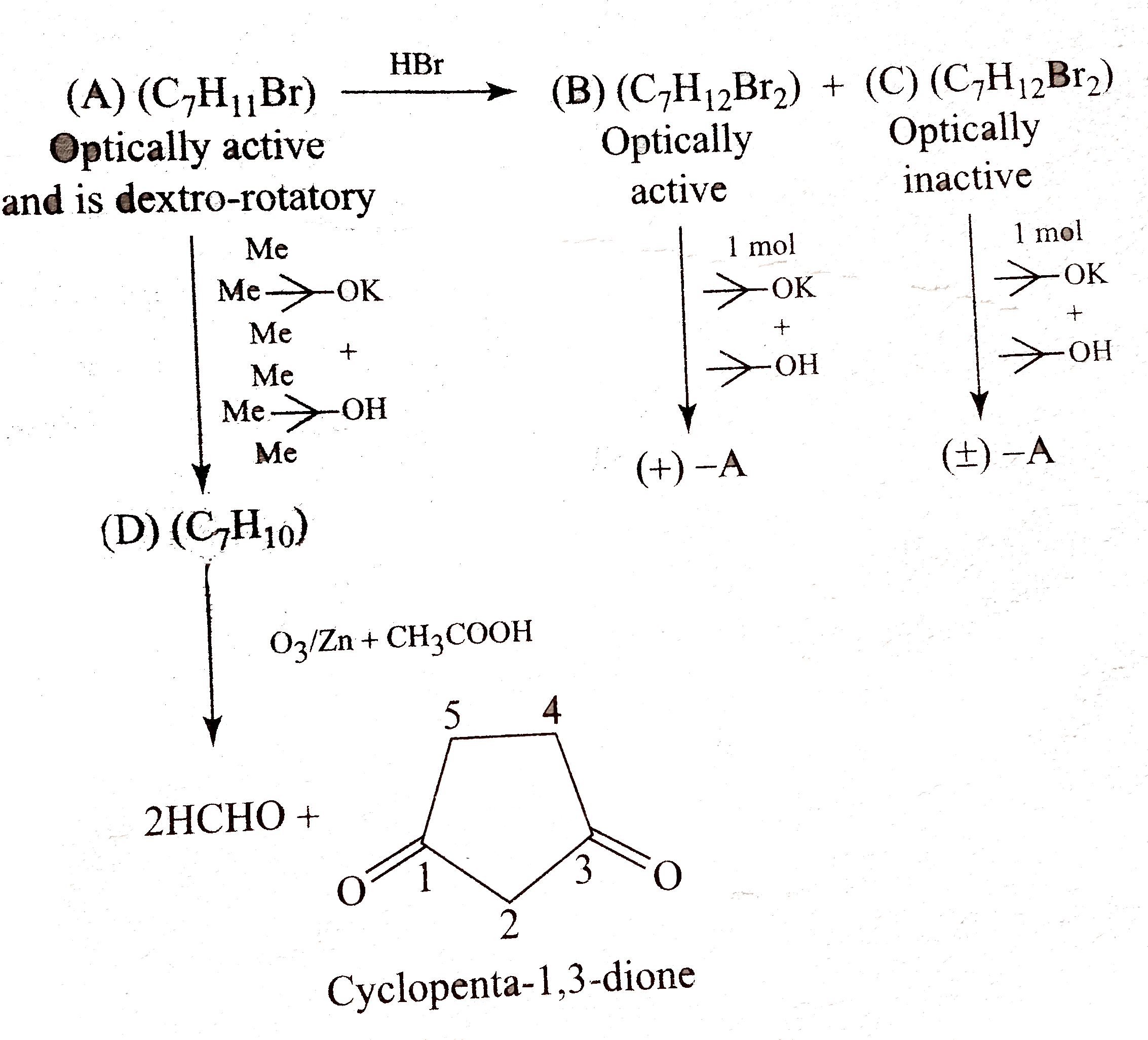The alkyl halide C4H9Br(A) reacts with alcoholic KOH and gives an alkene (B) which reacts with bromine to give a dibromide (C). (C) is transformed with sodamide into a gas (D) which forms a precipitate when passed through ammoniacal silver nitrate solution. Give the structural formulae of the compounds (A), (B), (C) and (D) and explain the reactions involved.
The compound A is CH3CH2CH2CH2Br1-bromobutane(C4H9Br)
The compound B is CH3−CH2−()CH=CH21-Butene
The compound C is CH3−CH2−Br∣CH−CH2Br1, 2-dibromobutane(C)
The compound D is CH3−CH2−C≡CHBut-1-yne(D)
As compound D forms precipitate with ammoniacal silver nitrate, it must be a terminal alkyne and must contain C-triple bond CH group. D is obtained from C by the action of sodamide (a dehydrohalogenating agent). C must be a 1, 2-dibromo derivative. Compound C is obtained by the action of bromine, on the alkene B. Therefore, B should be a 1-alkene and consequently A should be 1-bromobutane. The suitable reactions are given below:
CH3CH2CH2CH2Br1-bromobutane(C4H9Br)(A)+KOH(alc)→CH3−CH2−CHBut-1-ene(B)=CH2+KBr+H2O CH3−CH2−CH(B)=CH2+Br2→CH3−CH2−Br∣CH−CH2Br1, 2-dibromobutane(C)
CH3−H∣C∣H−Br∣C∣H−H∣C∣Br−HNaNH2−−−−→−2HBrCH3−CH2−C≡CHBut-1-yne(D)
CH3−CH2−C≡CH+[Ag(NH3)2]NO3→CH3−CH2−CSilver butynide(White precipitate)≡−C+Ag+NH4NO3+NH3
Topper's Solved these Questions
Similar Questions
Give the stereochemical forculae for (A),(B)(C), and (D) and also give the reactions involved.

View SolutionPrimary alkyl halide C4H9Br :
(a) reacted with alcoholic KOH to give compound (b) is reacted with HBr to give : (c) which is an isomer of (a). When (a) is reacted with Na metal, it gives a compound (d), C8H18 hich is different from the compound formed when n-butyl bromide is reacted with Na metal. Give the structural formula of (a) and write the equations for all the reactions.
View Solution
Knowledge Check
Primary alkyl halide C4H9Br (X) reacts with alc. KOH to give compound (Y). (Y) reacts with HBr to give compound (Z) which is an isomer of (X). When (X) reacts with Na metal it gives compound (P). (X), (Y), (Z) and (P) are
A X Y Z PCH3−CH∣CH3−CH2BrCH3−C∣CH3=CH2CH3−Br∣C∣CH3−CH3C8P18B X Y Z PCH3CH2CH2CH2BrCH3CH=CHCH3CH3−CH∣Br−CH2CH3C5H10C X Y Z PCH3−CH∣Br−CH2CH3CH3CH=CHCH3CH3CH2CH2CH2BrC7H14D X Y Z PCH3−CH∣CH3−CH2BrCH3CH=CHCH3CH3−CH∣Br−CH2CH3C6H12
Primary alkyl halide C4H9Br :
(a) reacted with alcoholic KOH to give compound (b) is reacted with HBr to give : (c) which is an isomer of (a). When (a) is reacted with Na metal, it gives a compound (d), C8H18 hich is different from the compound formed when n-butyl bromide is reacted with Na metal. Give the structural formula of (a) and write the equations for all the reactions.
View SolutionPrimary alkyl halide C4H9Br :
(a) reacted with alcoholic KOH to give compound (b) is reacted with HBr to give : (c) which is an isomer of (a). When (a) is reacted with Na metal, it gives a compound (d), C8H18 hich is different from the compound formed when n-butyl bromide is reacted with Na metal. Give the structural formula of (a) and write the equations for all the reactions.
View SolutionAn alkyl halide C5H11 (A) reacts with ethanolic KOH to give an alkene 'B' which reacts with Br2 to give a compound 'C' which on dehydromination gives an alkyne 'D' . On treatment with sodium metal in liquid ammonia one mole of 'D' give one mole of the sodium salt of 'D' and half a mole of hydrogen gas . Complete hydrogenation of 'D' yields a straight chain alkane. Identify A, B, C and D . Give the the reactions involved.
View SolutionWith alcoholic potash, C4H8Cl2 (A) gives C4H6 (B), which reacts with ammoniacal cuprous chloride. Identify the compounds (A) and (B).
View SolutionA hydrocarbon 'A' (C4H8) on reaction HCl gives a compound 'B', (C4H9Cl) which on reaction with 1 mol of NH3 gives compounds 'C' (C4H11N). On reacting with NaNO2 and HCl followed by treatment with water compound 'C' yields an optically active alcohol, 'D'. Ozonolysis of 'A' given 2mols of acetyldehyde. Identify compound 'A' to 'D'. Explain the reaction involved.
View SolutionA hydrocarbon 'A' (C4H8) on reaction HCl gives a compound 'B', (C4H9Cl) which on reaction with 1 mol of NH3 gives compounds 'C' (C4H11N). On reacting with NaNO2 and HCl followed by treatment with water compound 'C' yields an optically active alcohol, 'D'. Ozonolysis of 'A' given 2mols of acetyldehyde. Identify compound 'A' to 'D'. Explain the reaction involved.
View SolutionA hydrocarbon 'A' (C4H8) on reaction HCl gives a compound 'B', (C4H9Cl) which on reaction with 1 mol of NH3 gives compounds 'C' (C4H11N). On reacting with NaNO2 and HCl followed by treatment with water compound 'C' yields an optically active alcohol, 'D'. Ozonolysis of 'A' given 2mols of acetyldehyde. Identify compound 'A' to 'D'. Explain the reaction involved.
View Solution
